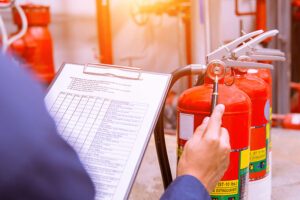Following the passing of the Fire Safety Act in April, Simon Molloy, National Fire Risk Assessment Manager at JLA, explains what Responsible Persons can do now to ensure they prepare ahead of the legislation becoming law.
 The Fire Safety Act (2021) has now received its Royal Assent, placing further accountability on businesses ‘Responsible Persons’.
The Fire Safety Act (2021) has now received its Royal Assent, placing further accountability on businesses ‘Responsible Persons’.
The act applies to all multi-occupied residential and commercial buildings and requires all Responsible Persons to assess, manage, and reduce the risk of fire posed by the structure and any common parts of buildings.
Following the Grenfell Tower tragedy in 2017, the existing fire safety legislation has been heavily debated and criticised, with public attention encouraging an upheaval to keep residents, and visitors of residential and commercial spaces, as safe as possible from the deadly risk of fires. With the new act introduced by the Home Office in April 2021, it is now well on its way to becoming enshrined in law.
But, how can residential and commercial teams tasked with this responsibility best prepare for the incoming legislation? With the act tipped to become law in early 2022, what can Responsible Persons do now to prioritise safety and security throughout their fire prevention strategy?
Update any fire risk assessments
A Fire Risk Assessment continues to be a legal requirement and promotes the long-term safety of both building occupants, and the building itself, against potential harm from fire and smoke. Businesses can either conduct an assessment themselves or bring in specialist risk assessors to provide extra peace of mind.
Addressing current risk assessments, ensuring that they are detailed, and containing step-by-step documents which identify the on-site areas that present a fire risk with itemised actions to help prevent incidents, is essential.
Whilst legislation for how often fire risk assessment should be completed is not set in stone, a commercial fire risk assessment should be carried out on an annual basis to gauge the risk of fire on your premises. That being said, carrying out a new assessment more often, say every six months or so, ensures that any changes in staffing, layout and operational considerations like social distancing are covered following closures or changes to the business due to coronavirus.
Install fire doors between resident properties and communal spaces
 For commercial property, physical barriers that prevent the spread of fire and smoke are essential.
For commercial property, physical barriers that prevent the spread of fire and smoke are essential.
Fire doors can provide a formidable defence in the event of uncontrolled combustion and can prevent fire from spreading between different residential flats and within commercial spaces. Even if lighter varieties are deemed too heavy for those who may have to use them, Responsible Persons can acquire devices that automatically close all doors when a fire alarm sounds but can be held open at other times for occupants to pass through.
For commercial and residential buildings, having a fire defence in place that suits the use of the space, allowing individuals to pass through, whilst also being effective in preventing a fire from spreading in an emergency, is a valuable addition in preparing for the incoming legislation.
Make life easier for fire services if they are needed
The reforms made to the Fire Safety Bill are intended to better clarify who is responsible for managing and reducing fire risks in different parts of multi-occupied buildings. If a fire event were to occur, making the Responsible Person recognisable to the emergency services will be essential.
Similarly, with the introduction of the legislation, preparing staff and Responsible Persons with the necessary fire safety training can support the emergency services in carrying out their job effectively, should a fire regrettably occur. This is because, if individuals know the evacuation plan, and are aware of the processes needed to evacuate residents and employees, the emergency services will be in the best position to put out the fire and ensure minimal damage occurs.
Perform regular fire alarm checks
Over the past 10 years, the number of fire safety audits has declined by over 43%. This means that many premises are at an added risk of fire simply because they have inadequate or poorly maintained fire systems and processes.
Fire alarms often detect unidentified fires before any person on-site and are thus a critical first line of defence. Regular checks on their performance are an essential fire safety undertaking. The British Standard BS5839 advises fire alarms to be checked at least twice a year, but the more checks completed throughout the year, the better.
For added peace of mind, professional site visits can provide a thorough analysis of all commercial fire alarm systems. Checks to detect faults or disablements can be carried out on fire alarm panel units, and core battery and device tests can be performed along with full sounder tests.
As the threat of fire is a constant worry for any business owner, all designated Responsible Persons must ensure that the premises are compliant with the recent Fire Safety Act 2021. With the legislation expected to be enshrined in law early next year, Responsible Persons and businesses should prepare now for the additional responsibility.
Updating any risk assessments, checking fire equipment and ensuring all staff are adequately trained for fire evacuation processes will ensure businesses are in the best position possible for when the act is introduced.
This article was originally published on IFSEC Global.
Fire Safety in 2023 eBook
SHP's sister site, IFSEC Insider has released its annual Fire Safety Report for 2023, keeping you up to date with the biggest news and prosecution stories from around the industry.
Chapters include important updates such as the Fire Safety (England) Regulations 2022 and an overview of the new British Standard for the digital management of fire safety information.
Plus, explore the growing risks of lithium-ion battery fires and hear from experts in disability evacuation and social housing.

 The
The  For commercial property, physical barriers that prevent the spread of fire and smoke are essential.
For commercial property, physical barriers that prevent the spread of fire and smoke are essential.
The “Responsible Person” is a legal term for employer, landlord etc. as the ‘person’ and not an individual human person.
In the article there is a strong inference that these responsibilities are on individuals.
This will only be the case if that individual is also the legal “Responsible Person” ie they are the (small) company or employer.
In larger organisations, duties (as activities) are devolved to a specific individual or group.
But the employer remains legally responsible.